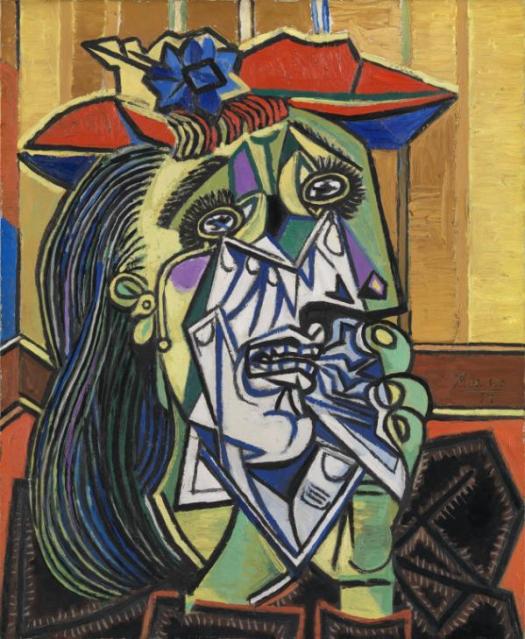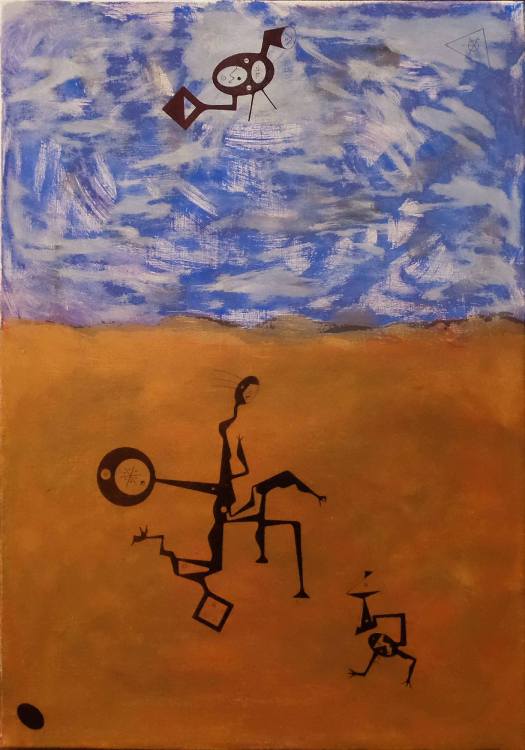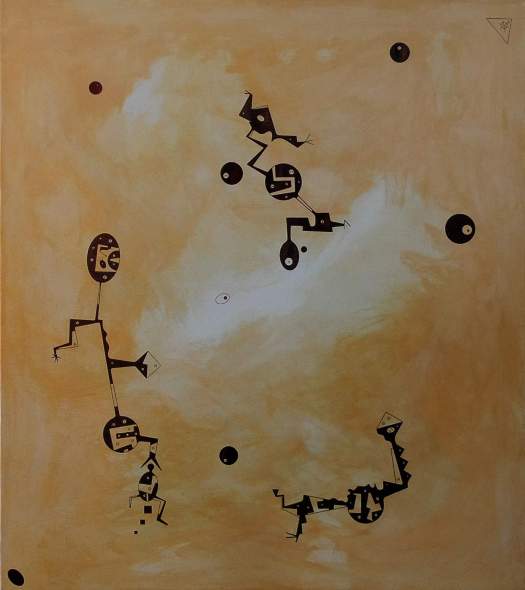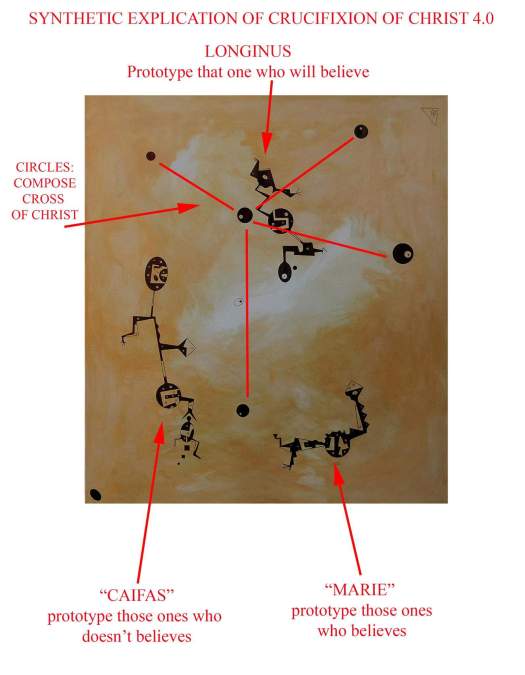Le Baron Carloluigi Columbo ist a mystery. He is fulfilling prophecy with his ars in colour on canvas, etc. He is begging an interview, the news muse is begging, because mysterious things have synergized around that which he keeps seeing, another prophecy or a continuation of revolutionary prophecy.
Before we take the dive into this unique destination in form of an artist, as per usual, let’s look backwards into the past of our art word. Let’s look for synergy, not plagiarized, for from out the schools of impressionism and color, it hath been useful to discover, WHERE the road may have wound, to get art students to see. Of course you may have guessed the geometric nature of the Baron’s ‘symbols’ would lead me to choose Picasso!

Look at the complexity of symbolism here, shape hath emotion, color. Such strong impressions of the visual artifact of humans. Our torn faces in the act of weeping are on display, symbolized by shape itself! Does shape, color, have meanings of their own? Surely they do, and the trailhead of that road to discovery was Picasso.
He was not alone on the journey to the kingdom of colour we now enjoy in fine art. The impressionist gave symbolic meaning to color and shape, and while some maintained this feat, our artist is fairly alone in taking the ‘shapes’ into a new place, a place of inky jangles, that of themselves take on the significance of script in some forgotten language. A new symbolic dictionary! Here the meaning of heaven and hell seem to unpack.

Here below, he tells the tales of a gypsy, he speaks of myths, new or old we do not know, for the soul of the subjects are the jangle of keys seen in the other film, but imagine those as gypsy runes, star runes, we’ll have a look in this episode at the art and ars of Gypsy Erin Neel. She seems to have predicted my visit to her on a recent weekend by providing me with a “plasma” pendant covered in a language very like the shapes upon your canvases the Baron.
Green crystal pendant by Erin Neel.

I finally got Erin’s pendant, I eventually had damaged the black wire runes weaved across the stone, so only the stone remains. A complete show, full of Celtic miracles is coming! The point is I was suddenly seeing keys jangling everywhere! Nice gruen colour is pleasing.
And now,, “Bagnante in a bikini” It should be your first inkling of a color language and so a colorist. This ist desert or Pueblo red sand for witch doctor, and water, spirits of water painted on a modern day cave wall of canvas, 10,000 years later.

Poor thing, dear reader, ist childhood color memory creeping again, already. Forest green crayons, ocean sings this note, we become ocean music. Ocean language!

We are these deeper symbolic selves, what though is a colorist but ink upon color. Consume the color blue and we are just jangles of Toltec magicians in the grand hall of Chaco, on the autumnal Equinox! Consume blau! Note when light hits the proto runes, they become sangre.
Black ist colour, see above a partial preview of the thick coloréd jangled with these thick ones, rendered completly in the colour black!
The above piece reminds, all color, all figures, seen anywhere on your canvas, must lead somewhere, as one. They cannot be separate figures but must sing together. Picasso achieved this by wrote means, as odd as he came be seen, he did it by classical art tutelage, and he was a fine student! Behold!

Children of art, this is what the master learned in school, the muscles strain in just the way of a seated wombyn, bending her back just so. A scetch is just a scetch, whether this finely interpreted or not, but blue is its own symphony, full of purple notes that give it something to be defined by a viewer, perhaps sadness itself. Picasso would never lose this language, though words of it were never stamped accross the squared space like Baron Charleslouis.
One cannot be too imaginative with one’s view of the artwork. The artist already embraces his form, feeling like the stick caricatures of a whole cohort of NY illustrators for magazines as far south as Dallas. He discards them like a Polar Bear Noble, and rushes off to face the next conceptual artist/colorist challenge, the sandstone yellow of desert prophecy (another grand historic coincidence) – the land of Palestine ist the land of American Indigenous, their Southwest, Chaco valley by equinox!

In case you missed it, he’s narrowed his palette by motif in each of these, without missing a colorist beat. Compare any two canvases of your eye ist lazy, aqua ist not blue, nor gold sandstone! Behold the colorist. Has he defined color uniquely, are these not all simple as black and white? Almost, they negate color, a great victory I have said, in daring to define color, make a word or a symbol out of it!


I have to say this is certainly making art criticism easier, but not understanding, as the border and fringe calligraphy upon the works of the Kier Collection speak to the beauty of the message, so he hath chosen a memorable language as old as that script. Haven’t you ever wondered linguistically where the Arabic that is so lovingly calligraphed got it’s curves. Where come the bends and twists in Indigenous Turanian language if scripted? Do not come to the gallery expecting no questions. The art asks things of the viewer!
Charleslouis has been very forthcoming in his willingness to be heard and understood in his spiritual and symbolic journey! Lately, after being banned for several months by Facebook, a very fascist censor, and my having commented on several, and as the colorists in the school appeared to be harkening to each others toolboxes of a colorist, happy it would seem to be reviewed. Hath Le Baron gained a new intense interest in color as one of his jangling symbols? The “jangles” fill the page as thick colored blocks, and not so much keys. We’ll see that Colombo last, but first a last defining look at the elder Spaniard.
Picasso never put linguistic symbols in his work, as far as we know. But what he achieved was the complete departure from the anatomical and physical, while somehow preserving it. Whether by shading or a slightly curving lotus-like line for a forearm. Here’s an example.

In “Les Femmes des Algiers”, now valued at almost 150 million we see art school perfection in a breast, a shoulder. We see the progression he made into abstraction, meanwhile maintaining all these elements. No one else has managed that. Chagall comes to mind, but his divorce from the anatomical is less strident than that of Picasso, though I personslly prefer the former.
A reader should know things about their art reviewer.
Look at the figure in the multicolored hat, her personality is being described to ye, using naught but geometry and colour, but the keys to the kingdom of art are still there. They are subtle reminders of the pipeline of classical art training, similar to the pipeline of classical music training, let’s say Paris and Moscow. This subtlety, is itself a high goal. The figures still bear the dismembered sections as gentle and natural curved edges, just as the anatomy of that breast. Academic, not meaning school boyish in general. The other meaning is short for The art academie de France, du Paris. That latter is this meaning, so he passed muster even, with a broken rule. Thick rather than thin defined lines go with washes like magnetic blue fields.
Charleslouis hath surprised us with this next piece, a last look at his own growth, is this then, the Revolutionary University school of color emerging? Decide that for yourselves, here is “The Green Revolution” like feasting on meaning, within color. In our vanity, we’d like to think Charleslouis meant the revolution of the ‘Green Man’ who hosts the show – King Elia in his green armor. He likely meant us to look at the hoopla and deception on offer, in what we call the “Green New Deal”. I must say I like the thought that he is painting about the old (new) Green Deal, that of the green king, lol.

Dont make any unbending deals, that do not deliver any meaning. Please support the artists directly by your patronage! All artists can be contacted through the contact page.
Support for the reviewer, photographers, editors, science contributors for this emag via Zelle at byronmontgomery@att.net
Or use phone number 972 256-6252

